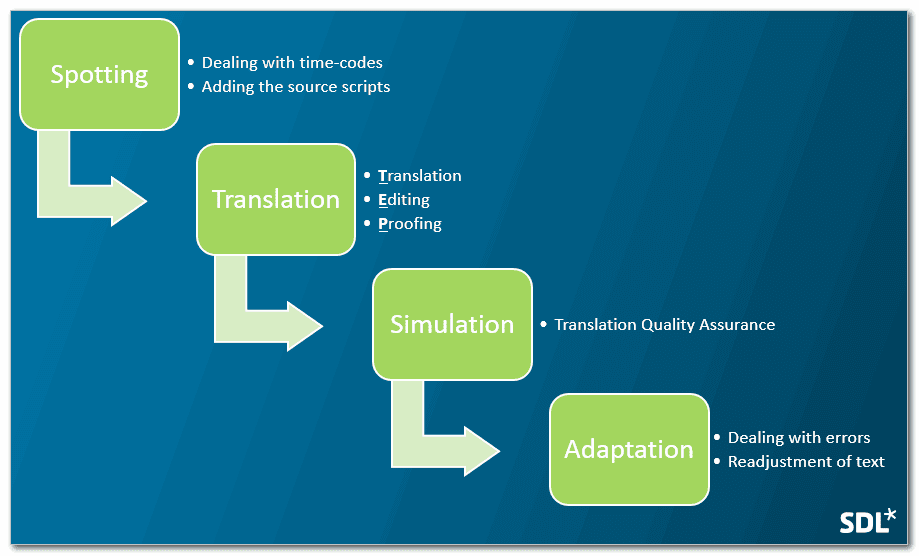According to the MESA Europe Content Localization Council in 2017, the size of the audiovisual translation market suggests that content localization services are worth about 2 billion USD per year and are expected to grow by 8% to 10% annually. The Slator 2018 Media Localization Report paints a similar picture, yet subtitle translation software has not grown to match this assertion. Is it because traditional TM (translation memory) technology has nothing to offer and can’t support this specialized localization process?
The Audiovisual Translation Process
A typical methodology in multimedia translation involves four main steps: spotting, translation, simulation, and adaptation.
Professional audiovisual translators are often responsible for all four of these steps. As TM technology has not provided an optimal environment for any part of this process, translators have simply been using subtitle editing software instead. But now, thanks to the solutions provided by the SDL Community Developers team, translators can use their preferred translation environment for more of the audiovisual translation process. This includes leveraging translation memories, managing terminology, and performing quality assurance checks.
Subtitle Solutions for TM Technology
Audiovisual Context
The first problem with TM technology is that it typically did not provide proper context when translating videos. A noteworthy solution to this challenge is the Studio Subtitling plugin, which supports audiovisual playback that works synchronously with the translation editor. It provides additional data in real time, such as the number of characters per line and reading speed, and is available when translating, editing, or proofing subtitle translation.
File Type Support
The second problem is that the audiovisual translation industry works with a very limited set of file types (considering the hundreds that are available through subtitling software tools like Subtitle Edit). The lack of support for subtitle file formats makes it harder for TM technology to be used properly. Indeed, in order to use it, these files must often be converted into either SRT — one of the few supported formats in translation tools — or Microsoft Word. Fortunately, new file type plugins have been developed for STL (Spruce), webVTT and SBV (youtube) — with plugins for ASS, TTML and DFXP due shortly, all in addition to SRT which is already available. This innovation ensures that SDL Trados Studio already supports more subtitle file formats than any other TM technology.
Time-Code Editing
TM technology typically works on the basis that the source files are sacrosanct and, therefore, should not be changed. However, a subtitled sentence often takes two, three, or even four screens to be completed, and its translation won’t necessarily be shown in the same order or have the same length as the original. So, the translator needs to be able to merge or split subtitles for them to make sense. This requires a change to the structure of the time-codes in the source file, and, until now, no TM technology has supported this to any extent. The Studio Subtitle plugin and associated file types solve this problem by ensuring that the timecodes are updated in the target file when the translator merges segments.
Translation Quality Assessment
Finally, the fourth problem relates to TQA (Translation Quality Assessment). Many models in the translation industry can be used in support of TQA, but none of them are suitable for checking the quality of subtitling. In fact, there is a general lack of an agreed model to support TQA for intralingual subtitling, and there are very few TM solutions that can support a TQA process at all.
This problem has been solved by building a TQA solution around the FAR model proposed by Professor Jan Pedersen of Stockholm University that supports assessment in three areas:
- Functional equivalence — do the subtitles convey speaker meaning?
- Acceptability — do the subtitles sound correct and natural in the target language?
- Readability — can the subtitles be read in a fluent and non-intrusive way?
This is only possible because SDL Trados Studio supports the use of a TQA model for review and because it is freely available as an optional TQA profile on the SDL AppStore.
Supporting Audiovisual Translation
The SDL AppStore is a first in the industry and remains the only way for developers to create solutions of their own using the open APIs that are made available through the SDL Language Platform. The Community Developers team has provided support for a subtitle translation software solution and made it available so that any user of SDL Trados Studio can download and install it for free.
If you work in the audiovisual translation field and lack the tools to help you leverage your translation resources, then give these solutions a try. The evolving nature of this subtitle translation software means it can continue to adapt and improve to always meet your needs!
If you have questions about SDL Trados’ subtitle translation software, don’t hesitate to reach out so you can find a suitable technology plan that caters to your needs. If you prefer working alongside your peers, you can also ask any questions you like in the community forum where a dedicated place is set up for discussions about subtitle translation software.
Do you work in the audiovisual translation field? What software and solutions have you found to support your translation process? Have you ever tried any of SDL Trados’ plugins? Let us know in the comments below! Curious about our other articles on translation? Check them out on the TCLoc master’s blog!



